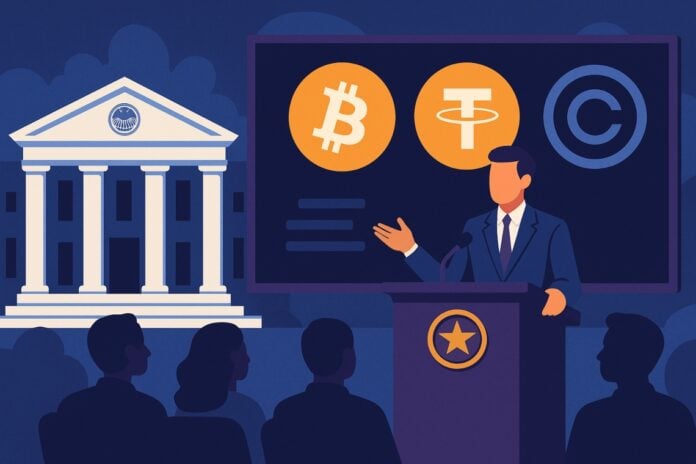Tomorrow, October 21, the Fed will explicitly discuss crypto.
In fact, the Federal Reserve will host a conference on payment innovation, which will also be attended by representatives from Chainlink, Paxos, Circle, and Coinbase.
It might be the first time that at an official conference organized by the Fed, one of the topics on the agenda is cryptocurrencies.
Summary
The Conference
The Fed conference where crypto will be discussed is the Payments Innovation Conference on October 21, 2025.
On the official website of the U.S. central bank, this conference is presented as a conference on payment innovation that brings together leading industry experts to share insights on the evolution of the monetary and payment landscape.
They also write:
“The Federal Reserve welcomes the opportunity to consider a wide range of perspectives on how to innovate and further enhance the payment system”.
Among this “wide range of perspectives,” cryptocurrencies also seem to be explicitly and officially included.
In fact, the official program of the conference begins with a round table titled “Creating a Bridge Between Traditional Finance and the Digital Asset Ecosystem” featuring the co-founder and CEO of Chainlink, Sergey Nazarov, along with Jackie Reses from Lead Bank, Michael Shaulov from Fireblocks, and Jennifer Barker from BNY, moderated by Rebecca Rettig from Jito Labs.
The second round table will be “Use Cases and Business Models of Stablecoins,” featuring Paxo’s Co-founder and CEO, Charles Cascarilla, and Circle’s President, Heath Tarbert, along with Tim Spence from Fifth Third Bank and Fernando Terres from Dolar App, moderated by Kyle Samani of Multicoin Capital.
At the third round table, titled “AI in Payments,” the CFO of Coinbase, Alesia Haas, will participate alongside Cathie Wood from Ark Invest, Emily Sands from Stripe, and James Tromans from Google Cloud, moderated by Matt Marcus from Modern Treasury, while at the last round table, titled “Tokenized Products,” Rob Goldstein from BlackRock, Jenny Johnson from Franklin Templeton, Don Wilson from DRW will speak and
Kara Kennedy from JPM Kinexys, moderated by Colleen Sullivan from Brevan Howard Digital.
For now, there are no other details regarding this, except that the conference will be broadcast live on the Fed’s official YouTube channel.
The Fed and crypto
Until now, the Fed had always been very cold towards Bitcoin and cryptocurrencies.
In fact, it seems that no clear step forward has ever been made in this direction, to the point that it appears no official event dedicated to this new sector has ever been organized or hosted.
The SEC, with Trump’s appointment of the new chairman Paul Atkins, has suddenly become crypto-friendly, after years spent on not only critical but also combative positions under the Democratic presidency of Gary Gensler.
The Fed, unlike the SEC, has never taken a clear and well-defined stance against the crypto sector, but it had also never truly opened up to this world.
This time, however, the opening not only seems clear, but it is also public.
The Role of BlackRock
The more attentive readers will have noticed the presence of BlackRock at the fourth and final round table, the one on asset tokenization.
The global finance giant is heavily pushing this technology, so much so that it seems to want to launch its own platform for asset tokenization.
The entry of BlackRock into the crypto sector in January 2024 with its Bitcoin ETF IBIT has completely changed the relationship between traditional financial institutions and the crypto world in the USA, while in other countries this shift has not yet occurred.
The “legitimization” of cryptocurrencies by BlackRock, which subsequently also issued an ETF on Ethereum, first led to greater acceptance of this phenomenon in the USA, and then also to a political opening.
The real turning point came with Trump’s electoral victory in November of last year, but already in May 2024 there had been another one, under Biden’s presidency, when the SEC was effectively ordered to approve ETH ETFs despite Gensler’s likely unfavorable opinion.
Subsequently, after Trump took office, all American financial institutions had to inevitably start dealing with the crypto sector, starting from the SEC and reaching up to the Fed.
The Federal Reserve
The Federal Reserve, often simply called the Fed, is the independent central bank of the United States of America, which decides and determines the monetary policy on the US dollar (USD), the global reference currency.
Its main task is precisely to manage the monetary policy of the USA, with a dual mandate: to support a high level of employment and to maintain price stability with controlled inflation.
It also has other secondary tasks, such as monitoring and containing systemic risks to maintain financial stability in the USA, supervising and regulating financial institutions to ensure their soundness and safety, and providing banking services to depository institutions, the United States government, and foreign official institutions.
It has existed since 1913 and operates with a good degree of independence from the U.S. government and Congress.
In light of this, its opening to the crypto world should be seen as an epochal event.


